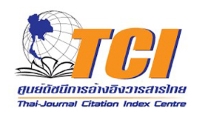JOURNAL DETAIL
Inhibitory Effects of Phenolic Compounds in Ocimum sanctum Extract on the α-glucosidase Activity and the Formation of Advanced Glycation End-products
Paper Type |
Research Article |
Title |
Inhibitory Effects of Phenolic Compounds in Ocimum sanctum Extract on the α-glucosidase Activity and the Formation of Advanced Glycation End-products |
Author |
Khwanta Kaewnarin and Nuansri Rakariyatham* |
Email |
nuansri1@yahoo.com |
|
Abstract: Hyperglycemia causes increased protein glycation which playsan important role in the development of chronic diabetic complications. Therefore, the inhibition of protein glycation is an alternative approach in decreasing the complications of diabetic pateints. This study primarily evaluated the antiglycation effects of five Lamiaceae plants (Ocimum basilicum, O. americanum, O. sanctum (green), O. sanctum (purple) and Metha cordifolia opiz.) using bovine serum albumin (BSA)-methylglyoxal (MGO) and histone-MGO models. Among Lamiaceae plant extracts, the crude ethanolic extract of O. sanctum (purple) was the most active species against protein glycationin both model proteins. The crude ethanolic extract of O. sanctum (purple) was partially purified by partitioning the extract into ethyl acetate (EA) and aqueous fractions and then investigating these fractions for advanced glycation end-products (AGEs)under different inducer models. The results indicated that the EA fraction of O. sanctum (purple) possessed strong inhibitory activities against AGE formation in both extracellular and intracellular proteins, including the use of different inducers. Moreover, this fraction also displayed the potent inhibition activity against α-glucosidase. The results of the LC-MS analysis of the EA fraction of O. sanctum (purple) revealed four phenolic compounds which were methyl eugenol, rosmarinic acid, luteolin and apigenin. These phenolics might be the bioactive compounds in the EA fraction of O. sanctum (purple) that contributed to antiglycation activities and antidiabetic properties through the inhibition of α-glucosidase activity, except for methyl eugenol which only showed α-glucosidase inhibition.
|
|
Start & End Page |
203 - 214 |
Received Date |
2014-01-16 |
Revised Date |
|
Accepted Date |
2014-11-20 |
Full Text |
Download |
Keyword |
antiglycation, Ocimum sanctum (purple), α-glucosidaseactivity, luteolin, rosmarinic acid, apigenin |
Volume |
Vol.44 No.1 (JANUARY 2017) |
DOI |
|
Citation |
Kaewnarin K. and Rakariyatham* N., Inhibitory Effects of Phenolic Compounds in Ocimum sanctum Extract on the α-glucosidase Activity and the Formation of Advanced Glycation End-products, Chiang Mai Journal of Science, 2017; 44(1): 203-214. |
| View:945 Download:355 | |
Copyrights © Since 2021 All Rights Reserved by Chiang Mai Journal of Science






